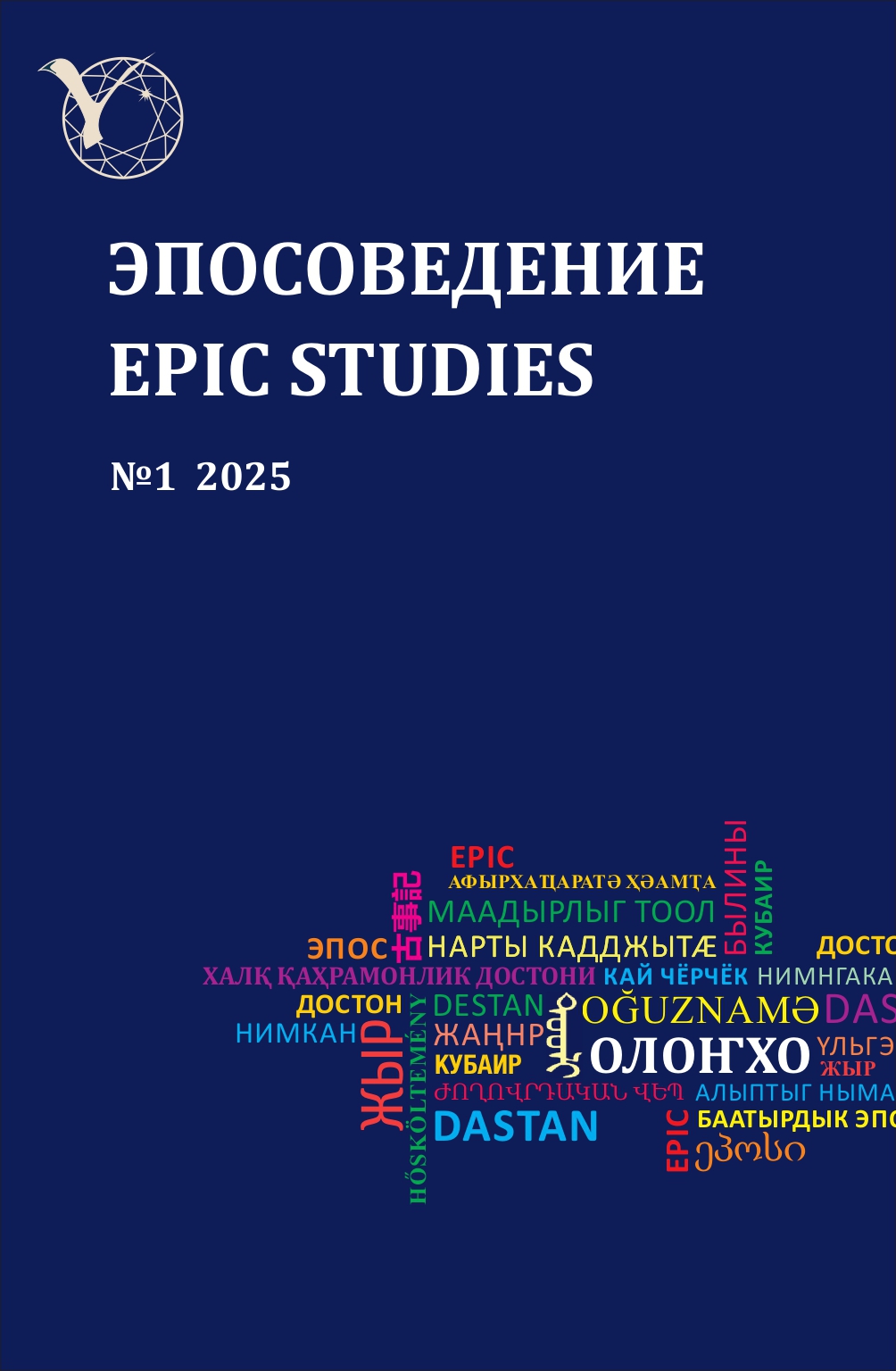Magic objects with the semantics of “viewing the universe” in the Khakas’ heroic tales
DOI:
https://doi.org/10.25587/2782-4861-2025-1-59-69Keywords:
heroic tales; Khakas; epicteller; hero; stable poetic descriptions; sun mirror; moon mirror; bat; folding knife; needle (needle eye)Abstract
The relevance of this topic is due to the need for a detailed, systematic analysis of the semantics, role, and function of specific magic objects in the Khakas’ heroic tales. The scientific novelty of the work lies in the fact that magic objects and tools, in particular with the semantics of “viewing the universe”, are subjected to detailed research for the first time. The purpose of this study is to identify and describe magic objects with the semantics of “viewing the universe”. To achieve this goal, it is necessary to solve the following tasks: to identify and describe stable poetic descriptions using the example of magic objects with this semantics; with a detailed analysis of specific magic objects, to identify similarities and differences in the texts of different storytellers; to determine the degree of reference to the epic plot and motifs. Descriptive, structural and semantic, comparative methods were used in the work. The category of magic objects under consideration includes: a sun mirror, a moon mirror, an aira (a bat), a jack-knife, a needle (needle eye). With the help of magic objects such as a kyun kyostik (a sun mirror) and an ai kyostik (a moon mirror), characters of an epic can see what is happening at any distance. Most often, in the texts of epic narratives, there is a jack-knife with nine sockets or a jack-knife with twelve sockets. Sometimes, the functions of a golden jack-knife coincide with the functions of a magic sun mirror. The mystery of a mirror reflection is completely transferred to a jack-knife. The power of a jack-knife to reflect light and shine gave it the same magical features and likened it to the magical features of a mirror. Despite the fact that the golden bat has magical features, nevertheless it does not possess the power of omniscience. This magic object is associated with the motifs of the hero’s departure from home in search of his parents and to battle with enemies, which compositionally forms the beginning of the action. The needle is used as one of the elements of military games. This magic object is associated with the motifs of difficult tasks and conditions for their solution, trials and other feats of the hero.
References
1. Meletinsky EM. The fairy tale hero. Origin of the image. Moscow: Oriental Literature Publ.; 1958:264 (in Russian).
2. Zhirmunsky VM. The legend of Alpamysh and the heroic tale. Moscow: Oriental Literature Publ.; 1960:331 (in Russian).
3. Zhirmunsky VM. The Turkic heroic epic. Leningrad: Nauka Publ.; 1974:726 (in Russian).
4. Propp VYa. Historical roots of a fairy tale. Leningrad: Leningrad University Publ. House; 1986:364 (in Russian).
5. Propp VYa. Morphology of a fairy tale. Moscow: Nauka Publ.; 1969:168 (in Russian).
6. Ungvitskaya MA, Mainogasheva VE. Khakas folk poetic creativity. Abakan: Khakas Branch of Krasnoyarsk Publ. House; 1972:311 (in Russian).
7. Lipets RA. Images of the batyr and his horse in the Turkic-Mongolian epic. Moscow: Nauka Publ.; 1984:262 (in Russian).
8. Mainogasheva VE. Notes to the translation. In: Kurbizhekov PV. Altyn Aryg. The Khakas heroic epic. Moscow: Nauka Publ.; 1988:535–556 (in Russian).
9. Mainogasheva VE. Khakas heroic epic Alyptykh Nymakh: search for historical realities and periodization (selected works). Abakan: Brigantina Publ.; 2015:228 (in Russian).
10. Chudoyakov AI. Sketches of Shor epic. Kemerovo: Kemerovo Book Publ. House; 1995:221 (in Russian).
11. Dugarov BS. Phenomenon of a book in the Turkic-Mongolian epic: Buddhist influence and Altai-Buryat parallels. Scientific notes (Altai State Academy of Culture and Arts). 2017;(1):82–88 (in Russian).
12. Ubushieva DV. Magic assistants in Kalmyk and Tuvan epic. New Research of Tuva. 2019;(4):165–175 (in Russian). https://doi.org/10.25178/nit.2019.4.14.
13. Sodnompilova MM, Gympilova SD. Healing techniques and healers’ attributes in the epic works of the Turkic-Mongolian peoples: to the origins of healing practices. Traditional Culture. 2021;22(4):112–122 (in Russian). https://doi.org/10.26158/TK.2021.22.4.009.
14. Orus-ool SM. Tuvan heroic tales (textual studies, poetics, style). Moscow: MAKS PRESS; 2001:422 (in Russian).
15. Chistobaeva NS. Role of magical objects in the Khakas epic narrative. Epic Studies. 2023;4(32):98–107 (in Russian). https://doi.org/10.25587/2782-4861-2023-4-98-107.
16. Chistobaeva NS. Means of healing and resurrection in the Khakas heroic tales. Epic Studies. 2024;2(34):53–66 (in Russian). https://doi.org/10.25587/2782-4861-2024-2-53-66.
17. Sagalaev AM, Oktyabrskaya IV (eds.) The traditional worldview of the Turks in South Siberia. Sign and ritual. Novosibirsk: Nauka Publ.; 1990:93 (in Khakas and Russian).
18. Mainogasheva VE. (ed.) Altyn Aryg. Khakas heroic epic. Moscow: Main Editorial Office of Oriental Literature; 1988:592 (in Russian). (Epics of the peoples of the USSR).
19. Sagalaev AM, Oktyabrskaya IV (eds.) The traditional worldview of the Turks in South Siberia. Human. Society. Novosibirsk: Nauka Publ.; 1989:243 (in Russian).
20. Novichkova TA. Epic and myth. Saint Petersburg: Nauka Publ.; 2001:247 (in Russian).
21. Subrakova OV, Beloglazov PE, Kaskarakova ZE (eds.) Khakas-Russian Dictionary. Novosibirsk: Nauka Publ.; 2006:1114 (in Russian).
22. Shulbayev SI. Ai Solbannan Kyun Solban: heroic epic. Abakan: House of Writers of Khakassia; 2021:292 (in Khakas).
Downloads
Published
How to Cite
Issue
Section
License
Copyright (c) 2025 EPIC STUDIES

This work is licensed under a Creative Commons Attribution 4.0 International License.
Copyright (c) 2021 Copyright (c) This work is licensed under a Creative Commons Attribution 4.0 International License.












 Olonkho Research Institute, M.K. Ammosov North-Eastern Federal University
Olonkho Research Institute, M.K. Ammosov North-Eastern Federal University